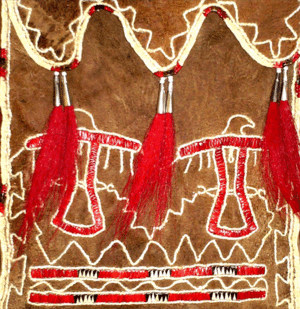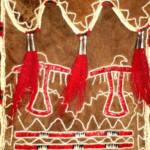The 1795 Treaty of Greenville brought a close to the Northwest Indian War, also known as Little Turtle’s War. Although Little Turtle helped to defeat Harmar’s and St. Clair’s armies, an impressive feat, the warriors of various tribal backgrounds later lost the Battle of Fallen Timbers in 1794, and a year later, the Treaty of Greenville dissolved the war. The very loose Native alliance was forced to surrender a large portion of Ohio, much of which was claimed by the Miami.
Little Turtle, a leader of the Miami, made it quite clear when speaking to American delegates and tribal representatives at the Treaty of Greenville, that they, the Miami, were the true owners of a large piece of the mid-west. He outlined the Miami’s homelands as extending from Detroit south to the Ohio River, west to the mouth of the Wabash, north to Lake Michigan, and east back to Detroit – claiming half of Ohio and all of Indiana. What’s more, it seems as no representatives of the other Old Northwestern tribes objected to his assertion (at least it wasn’t noted to be challenged), giving the appearance that the Miami’s neighbors, many of which had established villages inside that perimeter, believed the claim to be correct. As far as the Little Turtle was concerned, those tribes were on his People’s lands at Miami invitation – they had no real claim to it (although the Miami did see it as each villages’ prerogative to be a part of land sales they resided on). Little Turtle was at first angry about the treaty and declared the Miami lands were not to be ceded, but then reluctantly signed his name and declared that he may be have been one of the last chiefs to sign it, but he would also be the last one to break it. He kept that promise, and more, Little Turtle realized that Miami lands were their most prized commodity when it came to Miami-American relations.
Little Turtle had already felt, before the treaty discussions, that the Native Peoples could no longer hold off an ever-growing sea of Americans, especially without British intervention. His prediction had only become realized by the majority of Native communities after their loss at the Battle of Fallen Timbers (1794). Little Turtle’s next move had to be carefully planned. He had to present a strong front during the treaty talks, to put as much power back on his side as possible. He displayed anger of the Americans’ wanting “his People’s” lands and loudly boasted of his role in the victory of St. Clair’s Defeat (historically the largest defeat of the United States by Native American forces), and after throwing around a little weight, Little Turtle then decided to sign, but did so with the objective of securing annuity payments for any and all sales made on Miami territory. His goal might have been to make the Americans think that pleasing him was key to smooth land negotiations in this defined region, regardless of other non-Miami established villages on the same tracts. If this was his strategy from the start of negotiations, than Little Turtle succeeded, gaining a rather large annuity for the Miami from the Treaty of Greenville, and becoming a major authority in the eyes of the Americans.
Little Turtle’s role before the Treaty of Greenville was nothing short of complete opposition of Americans, especially on the battlefield, while his role after was one to “keep the peace” between the Miami and a few neighboring tribes with the Americans. Essentially, the treaty solidified his authority to both war captain and civil chief, not only in the American’s eyes but also on the Miami front. Traditionally, war captains were not eligible for positions of civil chiefs; the two domains were to remain separate. Not only that, war captains did not have any real authority in civil matters, their influence being confined to the battlefield. And while any warrior with an excellent track record and the support of their community could climb to the position of war captain, only certain individuals were eligible for the position of civil chief. Eligibility for civil chief was traditionally passed from father to son, or at times, through women (ie a man to his sister’s son – uncle to chief through a woman). Even more interesting is that in the transition, the mothers of the future chiefs become very loud and assertive in public affairs especially while instructing their sons and grooming them to take public office; her behavior was probably to announce and publicly confirm his coming role, made legal by her position in the family.
Indeed, Little Turtle was a war captain, most likely earning his position during the American Revolution. Yet his role as war captain should have also presented an obstacle in gaining authority in civil matter, however in Little Turtle’s time, there had been a growing trend among many mid-western tribes to put more authority in their war captains, blurring the line between war captains and civil chiefs. Little Turtle and his rival Tecumseh were both war captains initially, yet both, taking advantage of European influences that favored single leaders that combined authority of war and civil matters, had capitalized on their war positions to gain authority in all tribal affairs.
What Little Turtle became can be defined in historical terms as an “annuity chief” – a leader who’s supporters included both his constituents and the American government; a leader who drew upon his financial resources obtained by American treaties and relations to keep a secured leader position within their tribe. While this explanation might make Little Turtle seem corrupt, it was actually his generosity toward his and allied tribes, his affective management of the Miami’s annuities, and his refusal to indulge in riches (debatable) that made him a beloved leader. However, to his rival Tecumseh and his followers, annuity chiefs like Little Turtle were considered to be corrupt and greedy.
There is some evidence that Little Turtle’s son-in-law, the adopted Miami captive William Wells, may have gained unmerited financial benefits through his relation to the Miami chief while acting as Indian Agent. In fact, William Wells despised Tecumseh and the Prophet long before they were considered threats by Little Turtle, most likely because the more influence the Shawnee brothers gained, the larger the threat of William Wells not retaining a higher cash flow to the Miami involving him – such annuities obtained by American perceptions of Little Turtle’s “control” over a large percentage of Native Peoples and lands. The more supporters Tecumseh and the Prophet gained, the less constituents were attributed to Little Turtle, and that risked a rival chief possibly winning large annuities at the expense of the Miami, and William Wells.
And it wasn’t just his son-in-law cited to have had less than the highest ethics, as Little Turtle himself may have given into accepting bribes while making treaties. Little Turtle was granted a personal annuity (bribe) by William Henry Harrison in an 1802 preliminary treaty, and in 1804, with the promise more annuities, Little Turtle signed away lands in the most southern part of Indiana. However, while bribery may have been at play, so was pressure. Corruption seemed to have infected all parties. Potawatomi chiefs had put pressure on the Miami to sell that track for the 1804 treaty, and later had even gone as far as to threatened war on the Miami if they didn’t sign the 1809 treaty that ceded yet another track of southern Indiana. The Miami initially didn’t want to sell, but the Potawatomi threat was a real one, as they were not only half the Natives present at the treaty grounds, but they also stood to receive the largest share of goods, a “gift” for supporting Harrison during negotiations. Yet, the Potawatomi may have thought they had grounds for such “bullying” as they claimed this reciprocity was long overdue for earlier treaties they signed at the request of the Miami, even if they had been less beneficial for the Potawatomi.
It was Little Turtle’s endorsement of the 1809 Treaty of Fort Wayne that sealed the fate of his influence. Little Turtle, who strongly apposed Tecumseh’s anti-American movement, was able up to this point to keep his Miami citizens happy under his authority. When the 1809 treaty lands were ceded, Tecumseh cited it as evidence for what he believed to be a growing corruption among all the annuity chiefs. Tecumseh’s message was essentially that Little Turtle and other annuity chiefs wouldn’t stop selling the Indian Peoples’ lands until there was no more to sell. The 1809 Treaty of Fort Wayne was the last straw, and some who had never questioned their annuity chiefs’ motives now took a second look at Tecumseh’s message. For the first time, Tecumseh was seeing real numbers of local followers. It also marked a serious change in the Shawnee brother’s movement, from the religious to the political. The 1809 treaty catapulted Tecumseh’s authority; before the treaty, the Prophet led the movement, and after, Tecumseh led the movement.
As much as Tecumseh was appalled by the 1809 Treaty of Fort Wayne, he was probably aware that it was the lucky break his anti-American establishment was in need of, resulting in attracting large numbers of new followers, including some Miami who were previously supporters of Little Turtle. Little Turtle’s authority did suffer a very real setback, but by November of 1811, the Battle of Tippecanoe resulted in the first major blow of the Prophet’s and Tecumseh’s pan-Indian alliance, and what authority Little Turtle had lost was considerably restored, especially with public respect. Little Turtle died in 1812.
Further Reading:
-“Tecumseh and the Quest for Indian Leadership” by R. David Edmunds.
-“The Miami Indians of Indiana, A Persistent People, 1654-1994” by Stewart Rafert.
-“Thinking and Believing: Nativism and Unity in the Ages of Pontiac and Tecumseh” by Gregory Evans Dowd, in “American Encounters: Natives and Newcomers From European Contact to Indian Removal, 1500-1850” edited by Peter C. Mancall and James H. Merrell.






